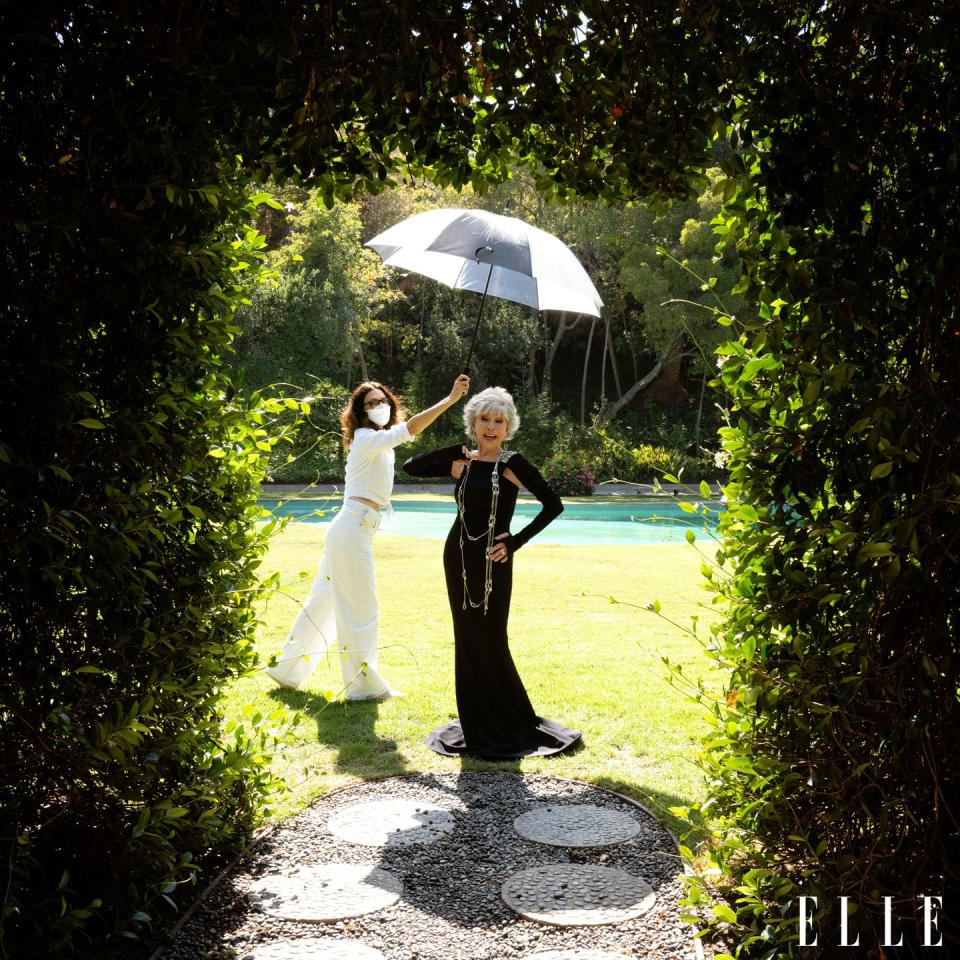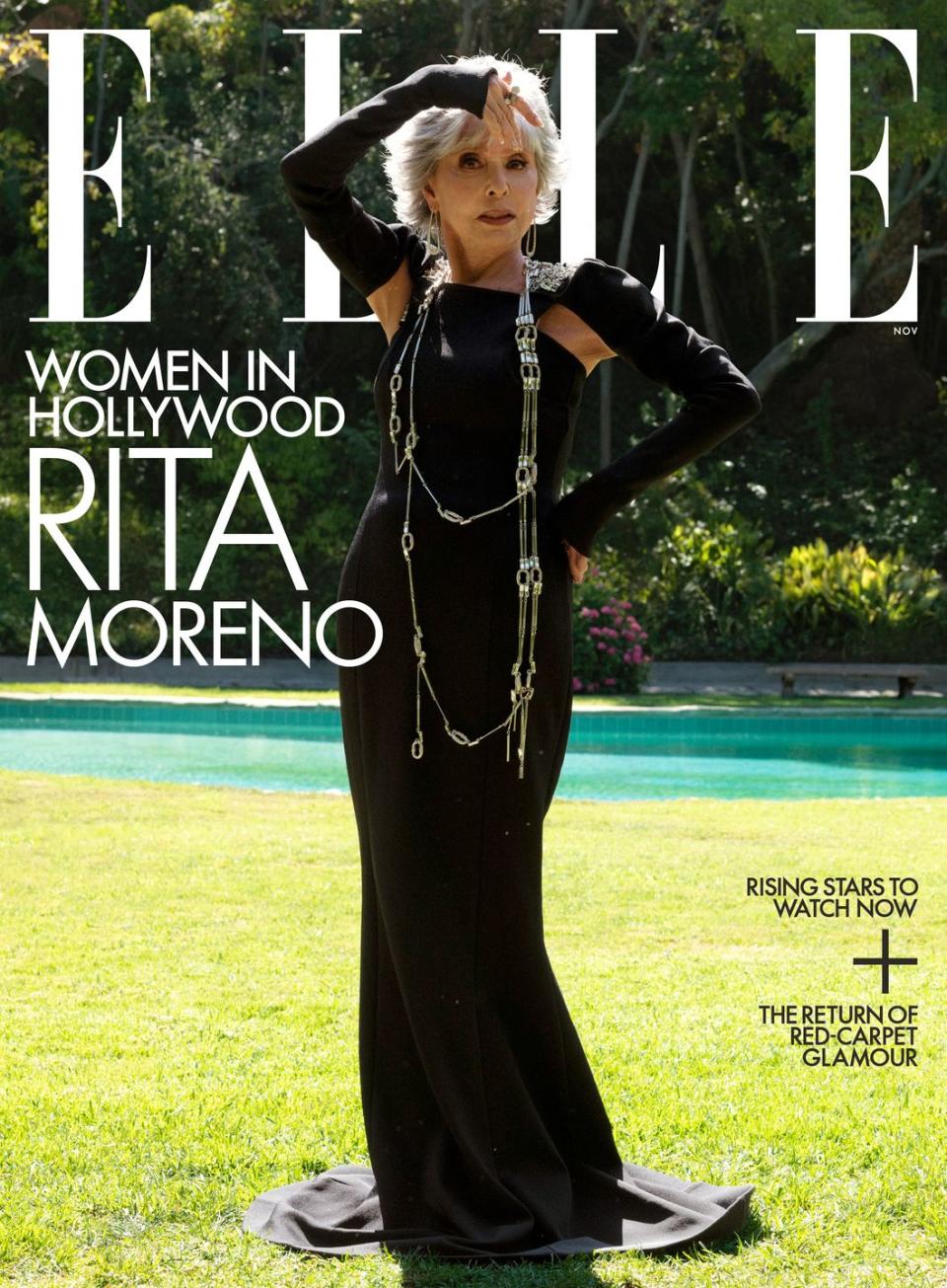Rita Moreno's Still Going For It

- Oops!Something went wrong.Please try again later.
"Hearst Magazines and Yahoo may earn commission or revenue on some items through the links below."

May I put it next to the little gold man? That’s what Rita Moreno’s eight-year-old grandson asked his abuela one day at her house two decades ago, when he showed her his youth club’s soccer award. Thus, next to her barrier-breaking 1962 West Side Story Academy Award sits a plastic trophy that reads: 2004 Thunderbolts—Justin. “I told him it will always be right here, and it always has been,” Moreno says.
The keepsake maintains stellar company. In the opening scene of the acclaimed Moreno documentary Rita Moreno: Just a Girl Who Decided to Go for It, the camera pans slowly past shelves lined with Moreno’s honors. There are Emmys, Grammys, the “little gold man” that earned her the historic claim as first Latina Oscar awardee, a Tony, a Golden Globe, and on and on, recognitions for her roles on Broadway, television, and film. She’s been honored by two presidents, testifying to her significance across party lines: President Bush gave her the Presidential Medal of Freedom in 2004, and she received the 2009 National Medal of Arts from President Obama.
Today, at 89 years old, Moreno doesn’t put much stock in awards. “More important is knowing the value of yourself and taking care of that,” she observes. That’s a lesson hard-earned for the actress and humanitarian, who tried to take her life decades ago after a long, tumultuous relationship with Marlon Brando. “Self-respect is one of the most difficult things to achieve when you’ve lived without it for years, as I did,” she says.
Moreno was born in Puerto Rico and moved at five with her mother to the Bronx, where she experienced racism for the first time. “I never let my mom know that kids called me names because I intuited that there was nothing she could do about it,” she recalls. She studied dance as a child, eventually signing with 20th Century Fox, which cast her in stereotypical roles (“Cantina Singer” and “Honey Bear” among them).
West Side Story proved a breakthrough moment, yet even after he rOscar win, studios failed to offer her substantive auditions. Thankfully, the rejections did little to crush her drive or newfound activism. At the request of civil rights icon and entertainer Harry Belafonte, she attended the March on Washington in 1963. “Standing up for causes may not have been the safest thing for my career, but that’s when my conscience came into play,” she says. “I decided a long time ago we have to help people when we can and if we’re able to.” From AIDS efforts in the 1980s to supporting bills expanding voting rights today, Moreno has continuously refused to stay silent. “Rita’s support of farm-workers and immigrant rights gave our community the visibility and respect we needed at a time when few of our voices were being listened to,” says civil rights legend Dolores Huerta. “She is an inspiration to all Latinas. She paved a path for women to follow.”
As she enters her tenth decade, Moreno now finds herself facing another unpleasant foe: ageism. “Hollywood hasn’t even begun to address this problem, considering the doting-grandmother typecasting that happens to silver-haired women like me,” she says.

Not that she’s accepting any of those roles. In next year’s indie dark comedy The Prank, Moreno plays a teacher accused of murder who is “one mean bitch,” she says. “It was so much fun.” But before that, a monumental homecoming awaits. Moreno has a leading role in the remake of West Side Story directed by Steven Spielberg. In this version, she plays a new character, Valentina. “Rita is an artist of enormous depth, power, and wit,” Spielberg says. “Her presence, her legendary career, and her life of political activism and advocacy will speak powerfully onscreen about the six decades that separate the original film and this new version, decades in which our country and our world have changed in many important ways. Of course, in many ways we haven’t changed nearly enough.”
In a life of historic firsts, Moreno continues to add to her ledger—this time as an executive producer of Spielberg’s remake. “I wanted her to join us as a collaborator. I needed her for her talent but also for her vast experience, her savvy, her knowledge of history, and her relationship to the history of West Side Story,” the director says. Of the inaugural credit, Moreno says, “It’s one of the most thrilling roles of my life.” Its cultural importance should not be underestimated: According to a study by the Center for the Study of Women in Television and Film at San Diego State University, only 21 percent of executive producer roles for 2020’s 250 top-grossing films were held by women (a USC Annenberg Inclusion Initiative study also found only 3 percent of all producers across the 1,200 top films were Latinos, despite being the largest ethnic minority group in the U.S.). As she preps for a milestone birthday later this year, Moreno continues to forge new paths for herself and those coming up be-hind her. “I told Steven, West Side Story had to come out before I turned 90,” she says with her characteristic charm. The theatrical release is set for December 10, the day before her big day. “He got it in just in the nick of time.”

Hair by Anna Maria Orzano; Makeup by Adam Christopher Dueñas; Produced by Jonathan Bossle at Tightrope Production.
This article appears in the November 2021 issue of ELLE.
You Might Also Like

